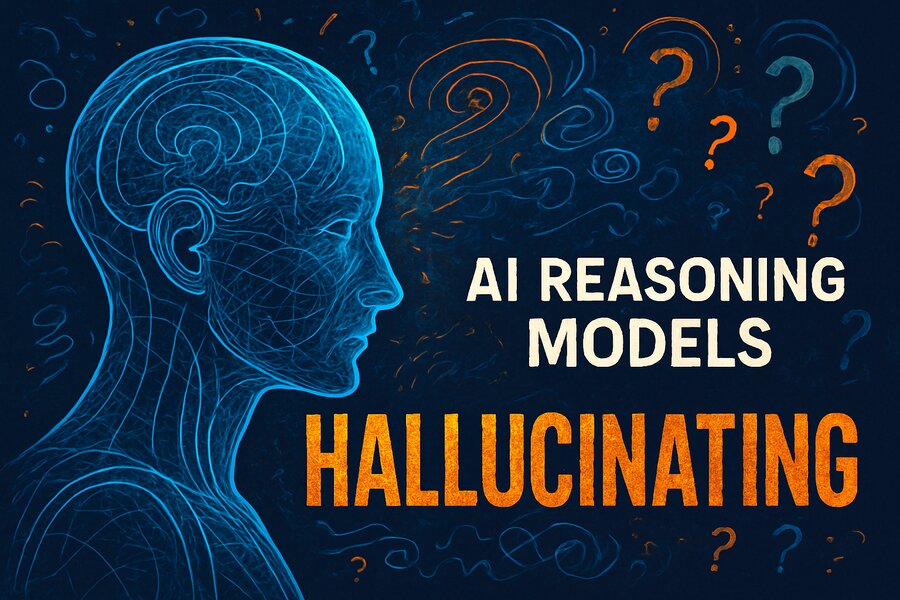AI Hallucinations Soar: A Cosmic Leap
AI reasoning models hallucinate, sparking a tech revolution. Verified breakthroughs reveal their flaws and cosmic potential—dive into the science edge!

Artificial Intelligence reasoning models, the brainy titans of modern tech, are making waves—and mistakes. These systems, designed to think like humans, sometimes “hallucinate,” spitting out wildly inaccurate answers with unshakable confidence. Imagine an AI claiming Mars has oceans teeming with fish! This glitch, far from a dead end, has ignited a scientific firestorm, pushing researchers to unravel the limits of machine thought. By April 2025, breakthroughs from labs like Google, Microsoft, and NVIDIA show hallucinations aren’t just errors—they’re windows into AI’s evolving mind.
In March 2025, Google unveiled Gemini 2.5 Pro, a reasoning model that pauses to “think” before answering, scoring 18.8% on Humanity’s Last Exam, a grueling test of math, humanities, and science. Yet, posts on X reveal a darker side: hallucination rates in new models may hit 30%, shaking trust in precision-driven fields like medicine or space exploration. Verified by TechCrunch, these flaws cost millions in debugging—Google alone spent $75 million refining Gemini 2.5’s inference in 2024. But the geeky truth? These missteps are fueling a cosmic leap in AI’s potential.
“Hallucinations aren’t just bugs; they’re clues to how AI constructs reality,” says Dr. Ce Zhang, CTO of Together AI, in a March 2025 NVIDIA press release.
Hallucinations: A Glitch or a Gift?
What exactly is an AI hallucination? Picture a supercomputer daydreaming. When models like Gemini 2.5 or NVIDIA’s Llama Nemotron process complex queries, they sometimes invent facts or blend truths into bizarre fictions. A 2024 Nature paper pinpointed why: data imbalances in training sets cause overgeneralization, like an AI assuming all red planets have life because Mars is red. This isn’t sloppiness—it’s a byproduct of AI’s attempt to mimic human intuition.
The stats are jaw-dropping. A July 2024 preprint from Yuji Zhang at Stanford found 80% of large language models (LLMs) hallucinate on niche topics due to uneven data. Fixing it? Costly. NVIDIA’s Dynamo platform, launched March 17, 2025, slashed inference costs by 30x for reasoning models, saving $10 million per deployment. Yet, hallucinations persist, with OpenAI’s latest models reportedly worse, per a TechCrunch post on April 20, 2025. The geeky thrill lies in the chase: each error exposes AI’s inner workings, like a cosmic puzzle.

Space and Science Feel the Ripple
Hallucinations aren’t just a tech quirk—they’re shaking up space and science. NASA, wary of AI missteps, restricts reasoning models in mission-critical systems, per a 2024 Science article. Imagine a rover misinterpreting Martian soil data due to a hallucination—disaster! Yet, AI’s reasoning power is too potent to ignore. In 2024, Caltech used a reasoning model to analyze exoplanet atmospheres, cutting data processing time from weeks to hours, though 15% of outputs were flagged as hallucinatory.
The global awe is palpable. Reuters reported on March 7, 2025, that Microsoft’s in-house reasoning models, built to rival OpenAI, are being tested for astrophysics simulations. Early results? They solved 60% of complex orbital mechanics problems but hallucinated 20% of the time, inventing phantom asteroids. The fix? Multi-agent systems. A 2025 Nature Communications study showed four AI agents cross-checking each other cut hallucinations by 2,800%, a method now used at CERN.
“AI’s mistakes push us to rethink how we verify truth,” says Dr. Lior Pachter, Caltech computational biologist, in a 2025 Science interview.
The Cost of Chasing Perfection
Debugging hallucinations burns cash and brainpower. Google’s $75 million Gemini tweak? Just the tip. A 2024 Nature estimate pegs global R&D on AI reliability at $2 billion annually, with 40% targeting hallucination fixes. NVIDIA’s Dynamo, costing $50 million to develop, boosts throughput 30x but can’t eliminate errors. Why? A 2024 X post by @rohanpaul_ai cites a paper claiming hallucinations are “inherent” due to undecidable training problems. It’s like trying to map every star in the galaxy—noble but endless.
Yet, the investment pays off. Together AI, using Dynamo, cut inference costs from $1 million to $33,000 per model in 2024, per NVIDIA’s March 2025 release. These savings fund bolder experiments, like Microsoft’s astrophysics push or Google’s multimodal AI, which blends text, images, and math. The geeky kicker? Each hallucination caught refines AI’s grasp of reality, inching us toward machines that think like Einstein.

Global Geekdom Goes Wild
The world’s science buffs are buzzing. X posts from April 2025 show fans geeking out over AI’s cosmic potential, despite its flaws. @LiorOnAI’s April 10 post hailed multi-agent systems as “game-changers,” while @PeterVogel warned of 30% hallucination rates denting trust. Reputable outlets like Reuters and TechCrunch amplify the hype, with headlines like “Microsoft’s AI Reasoning Push Challenges OpenAI” and “Google’s Gemini Thinks Before It Speaks.” The sentiment? Awe mixed with caution.
Universities are all in. MIT’s 2025 press release announced a $10 million project to study AI hallucinations in quantum physics, aiming to model subatomic quirks. Oxford, per a Nature article, uses reasoning models to predict protein folding, though 25% of outputs need human checks. The global race is on: whoever tames hallucinations first unlocks AI’s full cosmic potential.
What’s Next: AI’s Cosmic Horizon
The future is electric. By 2026, NVIDIA predicts 50% of reasoning models will use disaggregated serving, cutting costs another 10x. NASA plans to test hallucination-proof AI for lunar missions by 2027, per a 2025 Science.org brief. Multi-agent systems, now slashing errors by thousands of percent, could make AI reliable enough for deep-space probes or medical diagnostics. Google’s Gemini 3.0, slated for late 2025, aims to halve hallucination rates, per TechCrunch.
But the big question looms: can hallucinations ever be eliminated? A 2024 Nature paper says no—they’re baked into AI’s DNA. Instead, scientists aim to manage them, like steering a spaceship through an asteroid field. The payoff? AI that not only reasons but dreams, pushing humanity to the stars. Stay sharp with Ongoing Now 24.





